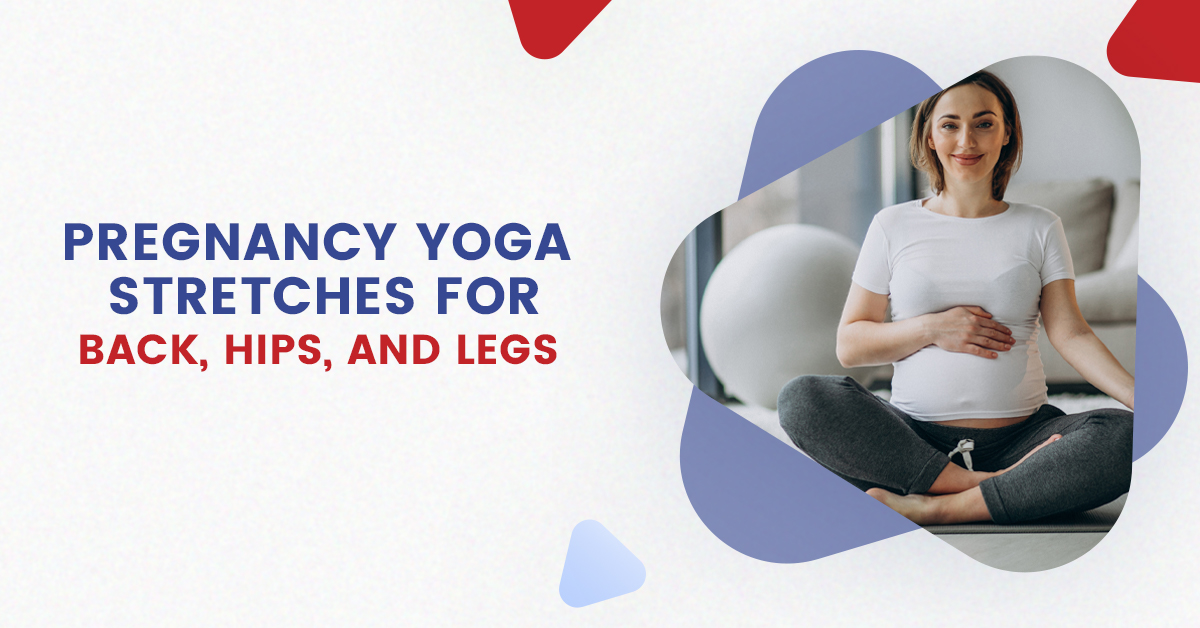Stretching during pregnancy has several advantages. You can stay healthy, unwind, and get ready for birth with its assistance. More importantly, it could be able to lessen some of the discomforts you’re feeling.
But before you begin, there are a few things to bear in mind. The hormone relaxin is naturally found in the body. Relaxin levels rise throughout pregnancy. When giving birth, it aids the body in relaxing the cervix and ligaments.
Additionally, relaxin lubricates and loosens the ligaments and joints of the pelvis, allowing you to overextend yourself during exercises like yoga. Because of this, stretching too vigorously can be harmful and even harmful to your health.
To avoid any potential problems, try not to hold positions for any longer than you could before getting pregnant. If you’re just getting started, be kind and gradual. Make sure your doctor has given you the go before practising pregnant yoga. Several pregnancy-related conditions make exercise potentially dangerous.
The Benefits Of Stretching During Pregnancy
Pregnant women who incorporated pregnant stretches into their weekly workouts also showed evidence of decreased pain during labour, increasing their likelihood of having a natural birth.
Here is a list of the stretch benefits.
- Improve circulation
- Prevent depression
- Rid fatigue
- Quiet the mind
- Reduce insomnia
- Improve digestion
- Reduce pelvic and leg cramps
- Ease ligament pain.
- Ease and prevent muscle tension.
- Sciatica back pain.
Precautions to take while stretching
Your body can benefit from stretching if you’ve checked with your doctor and received the all-clear for physical activity, including stretches, during pregnancy. Just be sure to heed this crucial safety advice:
- Warm-up. Always warm-up before diving in because stretching out cold muscles might lead to damage. It should work after a few minutes of brisk walking or alternating knee raises in place.
- Don’t bounce. A strained muscle could arise from bouncing when stretching. Instead, concentrate on holding each stretch for 20 to 30 seconds, moving into each position as far as you can, and holding at a point where you feel the strain but not discomfort.
- Don’t overdo it. The relaxin hormone your body produces throughout pregnancy helps to facilitate labour by loosening pelvic ligaments. However, because relaxin affects every ligament in your body, you’ll probably be more flexible from head to toe, which may ultimately cause overstretching and injury. The greatest method to defend yourself is to pay attention to your body and stick to a range of motion that never hurts.
10 Best Stretches During pregnancy
Pregnancy yoga poses for back pain
- Ankle-to-Knee Pose
Always perform hip openers for back pain This position will aid in releasing tension from your glutes and the muscles under your glutes, such as the piriformis, in addition to making room for your belly and opening up your back.
How to do it
Place your feet flat on the floor, bend your knees, and relax your shoulders. The right knee should be on the floor as you slide your right foot under your left knee (like half of a regular cross-legged position).
Stack the left shin on top of the right shin so that the left knee is on the right foot and the left foot is on the right knee. Gently place your palms on your knee and foot or join them in prayer (Anjali mudra).
Hinge ahead for a longer span. Alternate leg positioning, then repeat on the opposite side.
- Seated Side Bend
A grumpy back will benefit from any side bend, Choose your preferred stance, whether your legs are crossed or not.
How to do it
Start by sitting up straight in a comfortable position with your legs crossed or folded into a half-lotus position. Lay your right hand comfortably on the ground.
Keeping your upper torso rotated and open as you look up at your left hand, extend your left arm straight up before bending to the right. Lower onto your right forearm for support as you slant your body to the side. On the opposite side, repeat.
- Standing Forward Bend
Another great exercise for reducing lower back discomfort is this simple forward bend, carried out with feet spread slightly wider than normal. To open your back, it’s also advisable to sway slightly from left to right while maintaining your legs lose.
How to do it
With your knees slightly bent and your hips level, stand with your feet wider than hip-width apart. When bending forward at the waist, keep the knees flexible and let the head fall toward the mat.
Holding onto your elbows with opposing hands can lengthen your spine. Don’t worry about exerting more effort to get to the ground. Change your arm grip so the opposing arm crosses on top after taking a few deep breaths.
Yoga poses for tight hips
- Yoga Squat variation with a block
You may feel more flexible as your pregnancy advances because of the hormone relaxin that your body produces.
You must exercise caution not to stray beyond your range of flexibility. In light of this, even though a yoga squat didn’t feel wonderful when you weren’t pregnant, it probably does now.
How to do it
Legs extended in front of you while you sit. Kneel one at a time, keeping your feet a little wider than hip-width apart and close to your seat. Lift off the seat and shift your weight to your feet to enter a low, broad squat.
Maintain a straight back while bowing your head in prayer and placing your hands together between your knees. If this is uncomfortable, perform a supported squat using a block (the block rests under your bum).
- Pigeon Pose
Perfect for releasing lower-back strain is this hip opener. It’s also quite soothing to sink into.
How to do it
Start on all fours with the hips above the knees and the shoulders over the wrists. Swing the right leg forward until the right knee is in line with the right wrist and the right foot is bent toward the left wrist.
Keep your left foot at a comfortable angle and your leg internally rotated as you stretch your left leg behind you. As opposed to being slanted out to the left, make sure your left leg is directly behind you.
Come down onto your forearms if it is more comfortable, join hands in prayer, and bow your forehead to contact your thumbs.
If your belly prevents you from bending forward, sit up straight in comfort while being careful not to overstretch your low back. On the opposite side, repeat.
- Low Lunge Twist Pose
Contrary to popular belief, pregnant women shouldn’t twist at all. The only ones you should avoid are those that force your body up against your knees.
Your internal organs experience this compression during closed twists, which alters blood flow. When you relax, your blood starts to flow more freely. And if nobody else were developing in the midst of that, that would be fantastic.
Stick to open, simple twists as a fix. It’s okay if you’re simply extending an open hand. None of the organs or joints is compressed.
How to do it
On all fours, begin. Put your left foot on the ground with your left leg 90 degrees bent and your right knee directly over your ankle.
Flex and extend your right foot behind you as you move into a low lunge with a straight right leg, keeping your palms firmly planted on the floor.
Allowing your sight to follow your hand, shift your weight to your right hand and raise your left hand toward the ceiling. On the opposite side, repeat.
Yoga poses for relieving belly weight
- Wide-Knee Child’s Pose
If you’ve practised yoga previously, you’re already aware of its potency. Anything that relieves the strain on your belly as you gain weight will feel wonderful because it is so heavy.
How to do it
Kneel on the ground with your butt on your heels, your big toes touching the ground, and your knees spread wider than hip-width.
Allowing your body to pass between your knees, slowly lower your chest to the mat. Lay arms across the body with palms facing up if that feels more comfortable. Alternatively, extend your arms aloft, touching the forehead to the mat.
- Cat-Cow Pose
Similar to the previous stance, anything that relieves pressure on your belly will feel wonderful. Don’t stress about forcing yourself into a deep back bend; instead, concentrate on breathing easily as you move.
How to do it
On all fours, begin. Take a breath, raise your head, and let your back curve naturally (without putting pressure on your low spine).
When you exhale, curl inward and circle your spine as you glance down and toward your navel. Continue alternating between the two stances as you breathe in and out.
- Wide-Angle Seated Forward Bend
Similar to some of the stances mentioned above, this one will relieve some of the strain on your low back and provide a reprieve from the weight of your stomach.
How to do it
Legs outstretched in front of you while you sit. Spread your legs wide like you’re straddling, but avoid straining your legs by pushing them more than they can go.
Feel the stretch in your hips as you lay your forearms on the floor in front of you with a flat back and lean your chest toward the floor.
Yoga pose for relieving leg pain
- Legs-up-the-Wall Pose
When you’re pregnant, lying on your back won’t always feel comfortable. At that time, it is advised to utilise a bolster or pillows so that your back is not straight when performing this pose.
Keep your feet elevated, such as on a little stool under your desk at work, even when you’re not practising yoga, to reduce swelling and soreness.


